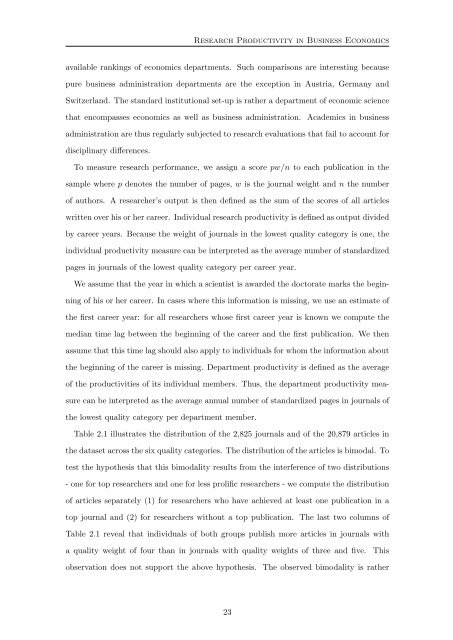Four Essays on University Economics - KOPS - Universität Konstanz
Four Essays on University Economics - KOPS - Universität Konstanz
Four Essays on University Economics - KOPS - Universität Konstanz
You also want an ePaper? Increase the reach of your titles
YUMPU automatically turns print PDFs into web optimized ePapers that Google loves.
Research Productivity in Business Ec<strong>on</strong>omics<br />
available rankings of ec<strong>on</strong>omics departments. Such comparis<strong>on</strong>s are interesting because<br />
pure business administrati<strong>on</strong> departments are the excepti<strong>on</strong> in Austria, Germany and<br />
Switzerland. The standard instituti<strong>on</strong>al set-up is rather a department of ec<strong>on</strong>omic science<br />
that encompasses ec<strong>on</strong>omics as well as business administrati<strong>on</strong>. Academics in business<br />
administrati<strong>on</strong> are thus regularly subjected to research evaluati<strong>on</strong>s that fail to account for<br />
disciplinary differences.<br />
To measure research performance, we assign a score pw/n to each publicati<strong>on</strong> in the<br />
sample where p denotes the number of pages, w is the journal weight and n the number<br />
of authors. A researcher’s output is then defined as the sum of the scores of all articles<br />
written over his or her career. Individual research productivity is defined as output divided<br />
by career years. Because the weight of journals in the lowest quality category is <strong>on</strong>e, the<br />
individual productivity measure can be interpreted as the average number of standardized<br />
pages in journals of the lowest quality category per career year.<br />
We assume that the year in which a scientist is awarded the doctorate marks the begin-<br />
ning of his or her career. In cases where this informati<strong>on</strong> is missing, we use an estimate of<br />
the first career year: for all researchers whose first career year is known we compute the<br />
median time lag between the beginning of the career and the first publicati<strong>on</strong>. We then<br />
assume that this time lag should also apply to individuals for whom the informati<strong>on</strong> about<br />
the beginning of the career is missing. Department productivity is defined as the average<br />
of the productivities of its individual members. Thus, the department productivity mea-<br />
sure can be interpreted as the average annual number of standardized pages in journals of<br />
the lowest quality category per department member.<br />
Table 2.1 illustrates the distributi<strong>on</strong> of the 2,825 journals and of the 20,879 articles in<br />
the dataset across the six quality categories. The distributi<strong>on</strong> of the articles is bimodal. To<br />
test the hypothesis that this bimodality results from the interference of two distributi<strong>on</strong>s<br />
- <strong>on</strong>e for top researchers and <strong>on</strong>e for less prolific researchers - we compute the distributi<strong>on</strong><br />
of articles separately (1) for researchers who have achieved at least <strong>on</strong>e publicati<strong>on</strong> in a<br />
top journal and (2) for researchers without a top publicati<strong>on</strong>. The last two columns of<br />
Table 2.1 reveal that individuals of both groups publish more articles in journals with<br />
a quality weight of four than in journals with quality weights of three and five. This<br />
observati<strong>on</strong> does not support the above hypothesis. The observed bimodality is rather<br />
23

















